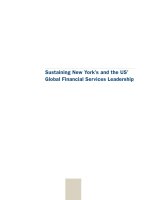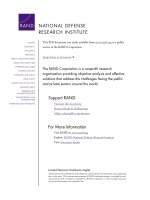British SMEs and the US market
Bạn đang xem bản rút gọn của tài liệu. Xem và tải ngay bản đầy đủ của tài liệu tại đây (901.9 KB, 5 trang )
SMALL AND MID SIZED ENTERPRISES
ON THE FRONTIERS OF EXPORTING
BRITISH SMES AND THE US MARKET
Supported by:
British SMEs and the US market
T
he “special relationship” between the US and UK has acquired new momentum among
Britain’s entrepreneurs recently. Over half (55%) of UK small and medium sized
enterprises (SMEs) that export abroad count the US among their markets, making the US
their top export destination, according to a 2014 survey.1
The UK’s Department of Trade and Investment (UKTI) calculates that in 2012, 17% of all
British exports went to the US 2 and that figure looks set to increase. While the UKTI has no
precise figures on SMEs, demand among firms receiving export help from the department
during 2013-14 rose most rapidly among those seeking to trade in the US – an increase
of 51%. 3 So far in 2014, the sectors receiving the most help from UKTI were consumer and
industrial goods, oil and gas, information and communications technology, and advanced
engineering – with biotech and creative media firms following closely behind.
The economic and cultural factors promoting UK exports to the US are clear. The US is the
world’s largest market, has the world’s biggest private sector, and poses few linguistic
problems for UK exporters. “The barriers to entry compared to Asia, for example,
linguistically and culturally – at the human level and in business terms – are very low,”
says Ben Halford, chief executive of the British production technology company Surface
Generation. “From that perspective, exporting to the US is a very easy step for UK SMEs.”
Surface Generation sells technology that improves manufacturing techniques, and an
important part of its service involves training customers in multinational corporations to
apply the technology in their home countries. While the company was able to do some of that
training via teleconferencing, it found that many US customers wanted Surface Generation’s
experts on site.
As a result, Surface Generation opened an office in Texas, which Mr. Halford says has a
regulatory regime for the aeronautical, automotive and consumer electronics sectors that
is similar to the one in the UK. He is planning to open a second US office, and is looking far
afield of Texas. “You have to have a good presence in the States on both the East and West
coasts to do well,” he says. “It’s best to pick one well-connected location and establish other
satellites after that.”
1
© The Economist Intelligence Unit Limited 2015
“US tops export
destination list for UK
SMEs,” Opinium Research
for Barclays Business in
August 2014
1
“Exporting to the USA,”
UKTI, April 2014
2
“Firms receiving
government support
increases by 50%,” UKTI,
October 2014
3
As Surface Generation expands its presence in both the US and Asia, it has decided to
quote prices in dollars in those markets, and to buy in dollars from its suppliers worldwide
wherever possible. While invoicing its clients in dollars poses an exchange rate risk when the
company repatriates revenues to the UK, Mr. Halford says the decision to purchase in dollars
significantly reduces the company’s exposure to currency fluctuations when it sells in the US.
As for many other UK SMEs, the biggest attraction of the US market is its sheer size.
“Investment in technology is done on a different scale in the US,” he says. “That requires UK
SMEs not to think on too small a scale. We can be too niche at times. UK SMEs need to scale up
and get on with it.”
The US market poses major challenges as well as big opportunities. UKTI says that typical
barriers for UK SMEs looking to export to the US include strong competition, high customer
service expectations, high cost of business insurance, and a cumbersome process for
obtaining work visas. In addition, due to their smaller size SME’s are more burdened than
their larger counterparts by technical and non-tariff barriers, according Allie Renison, Head
of Europe and Trade Policy at the UK Institute of Directors (IoD). Those barriers can include
complex customs procedures, duplicate safety testing of certain products – such as food and
clothing – and complying with different EU and US product standards.
The proposed Transatlantic Trade and Investment Partnership (TTIP) between the US and
the European Union may reduce such trade barriers by harmonising processes and reducing
customs duty charges. The economic benefit to Europe could reach €119bn a year by 2027,
according to research done by the Centre for Economic Policy Research on behalf of the
European Commission. 4 Of that amount, the Centre estimates that €25bn could come from
lower tariffs, and the rest from reducing technical and non-tariff barriers.
According to the IoD’s research, UK SMEs in the textile, food and drink, logistics and
pharmaceutical industries all stand to benefit hugely from TTIP. For example, small and midsized clothing manufacturers are leading a revival in niche fashion markets, but face import
duties of up to 40% on some products. In the biomedical sector, UK SMEs include producers
of innovative technologies which suffer from differences between US and UK safety testing
requirements. As the UK and the US do not recognise each other’s testing procedures, these
businesses typically must test their products twice to satisfy the separate requirements.
“Reducing Transatlantic
Barriers to Trade and
Investment: An Economic
Assessment,” March 2013,
Centre for Economic Policy
Research
4
Such agreements could make the US an even more popular destination for UK businesses, Ms.
Renison says. “There are entrepreneurs who have thought about exporting to the US and have
decided it is too time-consuming and too cumbersome,” she adds. “TTIP could encourage
many of those businesses to think again.”
2
© The Economist Intelligence Unit Limited 2015
While every effort has been taken to verify the accuracy
of this information, neither The Economist Intelligence
Unit Ltd. nor Novartis can accept any responsibility or
liability for reliance by any person on this white paper or
any of the information, opinions or conclusions set out
in this white paper.
GENEVA
Boulevard des Tranchees 16
1206 Geneva
Switzerland
Tel: +41 22 566 24 70
E-mail:
LONDON
25 St James’s Street
London, SW1A 1HG
United Kingdom
Tel: +44 20 7830 7000
E-mail:
FRANKFURT
Hansaallee 154, “Haus Hamburg”
60320 Frankfurt am Main
Germany
Tel: +49 69 7171 880
E-mail:
PARIS
6 rue Paul Baudry
Paris, 75008
France
Tel: +33 1 5393 6600
E-mail:
DUBAI
PO Box 450056
Office No 1301A
Thuraya Tower 2
Dubai Media City
United Arab Emirates
Tel: +971 4 433 4202
E-mail:









